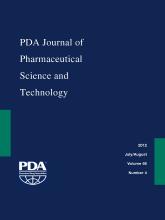Abstract
Pharmaceutical products are generally subjected to end-product batch testing as a means of quality control. Due to the inherent limitations of conventional batch testing, this is not the most ideal approach for determining the pharmaceutical quality of the finished dosage form. In the case of terminally sterilized parenteral products, the limitations of conventional batch testing have been successfully addressed with the application of parametric release (the release of a product based on control of process parameters instead of batch sterility testing at the end of the manufacturing process). Consequently, there has been an increasing interest in applying parametric release to other pharmaceutical dosage forms, beyond terminally sterilized parenteral products. For parametric release to be possible, manufacturers must be capable of designing quality into the product, monitoring the manufacturing processes, and controlling the quality of intermediates and finished products in real-time. Process analytical technology (PAT) has been thought to be capable of contributing to these prerequisites. It is believed that the appropriate use of PAT tools can eventually lead to the possibility of real-time release of other pharmaceutical dosage forms, by-passing the need for end-product batch testing. Hence, this literature review attempts to present the basic principles of PAT, introduce the various PAT tools that are currently available, present their recent applications to pharmaceutical processing, and explain the potential benefits that PAT can bring to conventional ways of processing and quality assurance of pharmaceutical products. Last but not least, current regulations governing the use of PAT and the manufacturing challenges associated with PAT implementation are also discussed.
LAY ABSTRACT: Pharmaceutical products are generally subjected to end-product batch testing as a means of quality control. Due to the inherent limitations of conventional batch testing, this is not the most ideal approach. In the case of terminally sterilized parenteral products, these limitations have been successfully addressed with the application of parametric release (the release of a product based on control of process parameters instead of batch sterility testing at the end of the manufacturing process). Consequently, there has been an increasing interest in applying parametric release to other pharmaceutical dosage forms. With the advancement of process analytical technology (PAT), it is possible to monitor the manufacturing processes closely. This will eventually enable quality control of the intermediates and finished products, and thus their release in real-time. Hence, this literature review attempts to present the basic principles of PAT, introduce the various PAT tools that are currently available, present their recent applications to pharmaceutical processing, and explain the potential benefits that PAT can bring to conventional ways of processing and quality assurance of pharmaceutical products. It will also discuss the current regulations governing the use of PAT and the manufacturing challenges associated with the implementation of PAT.
- © PDA, Inc. 2012
PDA members receive access to all articles published in the current year and previous volume year. Institutional subscribers received access to all content. Log in below to receive access to this article if you are either of these.
If you are neither or you are a PDA member trying to access an article outside of your membership license, then you must purchase access to this article (below). If you do not have a username or password for JPST, you will be required to create an account prior to purchasing.
Full issue PDFs are for PDA members only.
Note to pda.org users
The PDA and PDA bookstore websites (www.pda.org and www.pda.org/bookstore) are separate websites from the PDA JPST website. When you first join PDA, your initial UserID and Password are sent to HighWirePress to create your PDA JPST account. Subsequent UserrID and Password changes required at the PDA websites will not pass on to PDA JPST and vice versa. If you forget your PDA JPST UserID and/or Password, you can request help to retrieve UserID and reset Password below.






